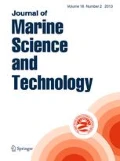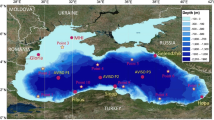Abstract
The present work aims to evaluate the wave energy resources in the Black Sea basin. The study is focused on the western part of the sea, which is traditionally considered as being more energetic. In order to give a first perspective of the wave climate, a medium-term wave analysis was carried out using in situ measured data. As a further step, a wave prediction system was implemented for the Black Sea. This was based on the simulating waves near-shore model, which is used for both wave generation and near-shore transformation. This methodology has the advantage that a single model covers the full scale of the modelling process. Various tests were performed considering data measured at three different locations. Special attention was paid to the whitecapping process, which is still widely considered to be the weak link in deep water wave modelling. Comparisons carried out against measured data show that the wave prediction system generally provides reliable results, especially in terms of significant wave heights and mean periods. By increasing the resolution in geographical space, the field distributions of wave energy were analysed for both high and average wave conditions. The analysis and the wave prediction system developed are a prerequisite for further investigations extended in time and with increased resolution in the near-shore direction.










Similar content being viewed by others
References
INCDM 1994 Study on the wave and wind climate close the Romanian littoral. Technical report, The Marine Research Institute Grigore Antipa, Constanţa (in Romanian)
Coman C (2004) EUROSION Case study technical report http://copranet.projects.eucc-d.de/files/000151_EUROSION_Mamaia.pdf
WAMDI Group (1988) The WAM model—a third-generation ocean wave prediction model. J Phys Oceanogr 18:1775–1810
Booij N, Ris RC, Holthuijsen LH (1999) A third-generation wave model for coastal regions. Part 1: model description and validation. J Geophys Res 104 C4:7649–7666
Stelling GS, Leendertse JJ (1992) Approximation of convective processes by cyclic AOI methods. In: Proceeding 2nd international conference on estuarine and coastal modeling, ASCE Tampa, Florida, pp 771–782
Booij N, Holthuijsen LH (1987) Propagation of ocean waves in discrete spectral wave models. J Comput Phys 68:307–326
Holthuijsen LH, Herman A, Booij N (2003) Phase-decoupled refraction–diffraction for spectral wave models. Coast Eng 49:291–305
Holthuijsen H (2007) Waves in oceanic and coastal waters. Cambridge University Press, Cambridge, p 387
Komen GJ, Hasselmann S, Hasselmann K (1984) On the existence of a fully developed wind sea spectrum. J Phys Oceanogr 14:1271–1285
Hasselmann K (1974) On the spectral dissipation of ocean waves due to white-cap. Bound-Lay Meteorol 6(1–2):107–127
Janssen PAEM (1991) Quasi-linear theory of wind-wave generation applied to wave forecasting. J Phys Oceanogr 21:1631–1642
Van Vledder G Ph, Hurdle DP (2002) Performance of formulations for whitecapping in wave prediction models. In: Proceedings of the 21st international conference on offshore mechanics and arctic engineering (OMAE 2002), ASME, Paper OMAE2002-28146
Yan L (1987) An improved wind input source term for third-generation ocean wave modelling, Scientific report WR-No 87-8, KNMI, De Bilt, The Netherlands
Alves JHGM, Banner ML (2003) Performance of a saturation-based dissipation-rate source term in modelling the fetch-limited evolution of wind waves. J Phys Oceanogr 33:1274–1298
Guedes Soares C, Weisse R, Carretero JC, Alvarez E (2002) A 40-year hindcast of wind, sea level and waves in European waters. In: Proceedings of the 21st international conference on offshore mechanics and arctic engineering (OMAE 2002), ASME Paper OMAE2002-SR28604
Guedes Soares C (2008) Hindcast of dynamic processes of the ocean and coastal areas of Europe. Coast Eng 55:825–826. doi:10.1016/j.coastaleng.2008.02.007
Valchev N, Pilar P, Cherneva Z, Guedes Soares C (2004) Set-up and validation of a third-generation wave model for the Black Sea, In: Proceedings of 7th International Conference on “BLACK SEA 2004”, pp 273–279
Hsu SA, Meindl EA, Gilhousen D (1994) Determining the power-law wind-profile exponent under near-neutral stability conditions at sea. J Appl Meteorol 33(6):757–765
Rusu E, Guedes Soares C (2008) Wave Energy assessments in the coastal environment of Portugal continental. In: The 27th international conference on offshore mechanics and arctic engineering OMAE 2008, ASME paper OMAE08
Author information
Authors and Affiliations
Corresponding author
About this article
Cite this article
Rusu, E. Wave energy assessments in the Black Sea. J Mar Sci Technol 14, 359–372 (2009). https://doi.org/10.1007/s00773-009-0053-6
Received:
Accepted:
Published:
Issue Date:
DOI: https://doi.org/10.1007/s00773-009-0053-6




